
Kottayam is one of 14 districts in the Indian state of Kerala. Kottayam district comprises six municipal towns: Kottayam, Changanassery, Pala, Erattupetta, Ettumanoor, and Vaikom. It is the only district in Kerala that neither borders the Arabian Sea nor any other states.

The Syro-Malabar Catholic Church, is an Eastern Catholic Church based in Kerala, India. It is sui iuris (autonomous) particular Church in full communion with the Pope and the worldwide Catholic Church, including the Latin Church and the 22 other Eastern Catholic Churches, with self-governance under the Code of Canons of the Eastern Churches (CCEO). The Church is headed by the Major Archbishop of the Syro-Malabar, currently George Alencherry. The Syro-Malabar Synod of Bishops canonically convoked and presided over by the Major Archbishop constitutes the supreme authority of the Church. The Major Archiepiscopal Curia of the Church is based in Kakkanad, Kochi. Syro-Malabar is a prefix reflecting the church's use of the East Syriac Rite liturgy and origins in Malabar. The name has been in usage in official Vatican documents since the nineteenth century.
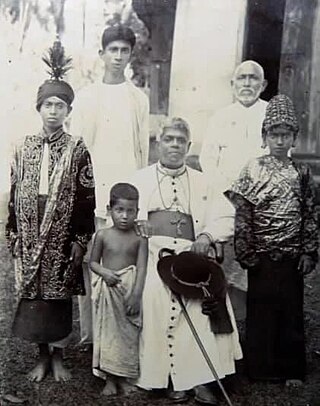
The K'nānāyalisten, also known as the Southists or Tekkumbhagar, are an endogamous ethnic group found among the Saint Thomas Christian community of Kerala, India. They are differentiated from another part of the community, known in this context as the Northists (Vaddakkumbhagar). There are about 300,000 Knanaya in India and elsewhere.
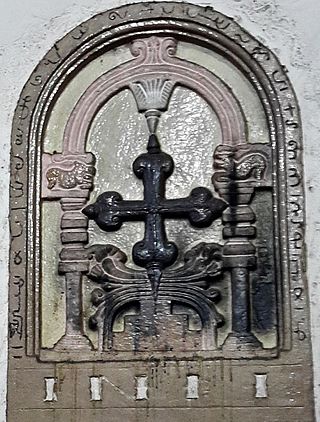
The Synod of Diamper (Udayamperoor Synod) (Malayalam: ഉദയംപേരൂർ സൂനഹദോസ്, romanized: Udayampērūṟ Sūnahadōs), held at Udayamperoor (known as Diamper in non-vernacular sources) in June 1599, was a diocesan synod, or council, that created rules and regulations for the ancient Saint Thomas Christians (also known as Mar Thoma Nasranis) of the Malabar Coast, a part of modern-day Kerala state, India, formally subjugating them and downgrading their whole Metropolitanate of India as the Diocese of Angamale, a suffragan see to the Archdiocese of Goa administered by Latin Church Padroado missionaries. This synod also introduced forced Liturgical Latinisation and the eschewal of local practices and beliefs, leading to a significant ecclesial protest by Saint Thomas Christians known as Coonan Cross Oath and a subsequent schism in the mid-17th century.

The Coonan Cross Oath, also known as the Great Oath of Bent Cross, the Leaning Cross Oath or the Oath of the Slanting Cross, taken on 3 January 1653 in Mattancherry, was a public avowal by members of the Saint Thomas Christians of the Malabar region in India, that they would not submit to the Jesuits and Latin Catholic hierarchy, nor accept Portuguese dominance in ecclesiastical and secular life. There are various versions about the oath's wording, one version being that the oath was directed against the Portuguese, another that it was directed against Jesuits, and yet another version that it was directed against the authority of Catholic Church.
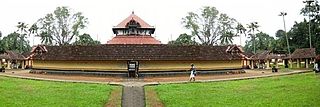
Kaduthuruthy is a town in Kottayam District in the state of Kerala, India.
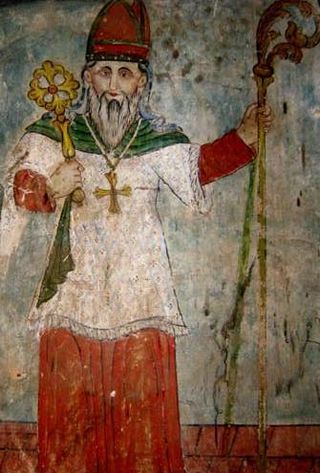
Mar Thoma I, also known as Valiya Mar Thoma and Arkkadiyokkon Thoma in Malayalam and Thomas de Campo in Portuguese was the first native-born, popularly-selected Metropolitan bishop of the 17th-century Malankara Church. He was the last Archdeacon of the undivided St. Thomas Christians of Malankara (Maliyankara).

This article lists the various old and ancient churches that exist among the Saint Thomas Christians in Kerala.

Saint Thomas Christian crosses are ancient crosses associated with the community of Indian subcontinent, who trace their origins to the evangelism of Thomas the Apostle in the 1st century AD. The Saint Thomas Christians, which is one of the oldest Christian communities of the world, survive in the Malabar region in state of Kerala, India and have a diaspora in other parts of the Indian subcontinent. Saint Thomas Christian crosses are known as Mar Thoma Sleeva, Indian cross, or Persian Cross in English, as well as Nasrani Sthambam in Malabarese.

This is a timeline of the history of the Syro-Malabar Catholic Church in India.

Mar Sabor and Mar Proth, according to Syrian Malabar Christian tradition, were two Chaldean Assyrian bishops who landed in the port of Kollam by the help of a Nestorian merchant, Sabr Iso in 823 AD. The mission is said to have received permission from the then king of Kerala to build a church in Kollam.

Palliveettil Chandy also known as Parambil Chandy was a bishop of the Catholic Saint Thomas Christians. He is also the first known native Indian bishop. He was the bishop of the East Syriac Rite (Chaldaean) faction after the Coonan Cross Oath in 1653. This faction returned to full communion with the Holy See of Rome, it would later become known as the modern-day Eastern Catholic Syro-Malabar Church. Mar Chandy's tomb is at the Marth Mariam Major Archiepiscopal Church at Kuravilangad.

Champakulam Kalloorkadu St. Mary's Basilica is an ancient Christian Church in Kerala. It belongs to the Syro-Malabar Church under the Archeparchy of Changanacherry. It is a Forane church, with several parishes under it.

The Eparchy of Palai is a Syro-Malabar Catholic ecclesiastical territory or eparchy of the Catholic Church with an area of 1166 km2 comprising the Meenachil taluk and a few villages of the neighbouring taluks in Kottayam, Ernakulam, and Idukki districts of central Kerala in South India. The faithful of this eparchy, numbering 326,742, belong to the ancient St. Thomas Christian community. The seat of the bishop is the St. Thomas Cathedral based in the town of Palai. The current bishop is Mar Joseph Kallarangatt, serving since March 2004. Mar Jacob Muricken has been auxiliary bishop since 2012.

Kottakkavu Mar Thoma Syro-Malabar Pilgrim Church is a Syro-Malabar church located in North Paravur. According to Saint Thomas Christian tradition, the church was established in 52 AD by St. Thomas, one of the twelve apostles of Jesus Christ. It is one of the first churches in India and is called an Apostolic Church credited to the Apostolate of St. Thomas who preached and also started conversion of people to Syriac Christianity here. It is one of the Ezharappallikal that he established in India; the other six churches were established at Kodungalloor, Kokkamangalam, Palayoor, Kollam, Niranam, and Nilackal.

The Holy Ghost Forane Church, or Ruha d Qudisha Church, located at Muttuchira village of Kottayam district, Kerala, India, is believed to be established in the sixth century AD and is one of the ancient churches in Kerala. The church is famous for the presence of ancient granite St Thomas cross, ancient stone writings and ancient mural paintings. The church is under the Syro-Malabar Diocese of Palai.
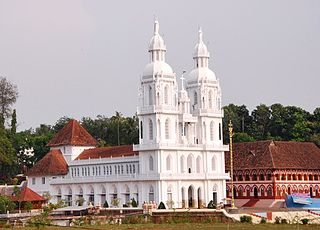
Major Archiepiscopal Marth Mariam Archdeacon Church, Kuravilangad is a Marian pilgrim center of the Syro-Malabar Church located at Kuravilangad in Kottayam district. This church claims to date to 105 AD. The church has an ancient bell with the engraving on Syriac language "Mother of God." Three majestic bells were brought from Germany in 1911 and is one of the largest bells in Asia. The church is also known for its Kappalottam or "racing ship," a commemoration of the biblical story of Jonah and the whale.

Kadavil Chandy Kathanar, also known as Alexander the Indian was a Kathanar (priest) and a celebrated scholar, orator, hymnographer and syriacist from the Saint Thomas Christian community in India. He was a prominent face of the Saint Thomas Christians and lead their Catholic faction during a turbulent period of divisions in the community after the Coonan Cross Oath of 1653. He was from Kaduthuruthy, Kottayam in Kerala state of India. He often reacted vehemently against the colonial Padroado latin subjugation over his community and resisted their ecclesiastical and cultural dominance. He was widely reputed for his knowledge in Syriac language and literature, and was often praised, both among his own community and the European missionaries who wrote about him in their letters addressed to the Portuguese monarch and to the Pope. His acrostic poems propagated even among West Asia's Syriac-speaking communities. Although he stood against the Latin colonialists, he commanded respect from the Portuguese and the local Hindu kings alike.
Angamāly Padiyōla is a historic declaration of the Syrian Catholic/ Syro Malabar (Paḻayakūṟ) Saint Thomas Christians proclaimed in 1787 at the Great Church of Saint George in Angamāly. This document made a strong appeal to the pope for the consecration of a native bishop for the community and demanded autonomy for their Church which was forcibly brought under the Latin Church's jurisdiction.
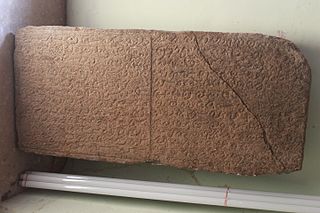
Jacob Pakalomattam was an Archdeacon of the Saint Thomas Christian community in India in the years preceding the Synod of Diamper in 1599. He was a native of Muttuchira and belonged to the Pakalomattam dynastic family. His activities were based in the Church of Ruha d'Qudisha in Muttuchira. He owed his staunch allegiance to the traditionalist Eliah Patriarchate of the Church of the East and Metropolitan Mar Shemon, who was sent to India by Patriarch Eliya VI Barmama. He protested against the Latinising attempts of the Portuguese Padroado and resisted the Chaldean Catholic attempts of reconciliation led by Joseph Sulaqa and Abraham of Angamaly. Throughout his archdeaconate, he is known to have rebelled against the Chaldean Catholic archdeacons including Givargis of Cross.


















